Motorola Xoom Review: The First Honeycomb Tablet Arrives
by Anand Lal Shimpi on February 23, 2011 11:57 PM ESTCharging
Motorola advertises that the Xoom can fully charge in half the time of its leading competitor, requiring only 3.5 hours to charge completely. I will say that the Xoom does indeed charge very quickly, but the quick charging comes at a price.
The iPad charges over USB, although on the iPad end it’s exposed as a standard Apple dock connector. Connect it to a USB port that supports the battery charging spec and you’ll be able to charge the iPad slowly, and only when locked. Otherwise you’ll need to rely on the Apple supplied 10W power adapter. The benefit to this finicky approach is that you only need to carry one cable to sync and charge your device. Obviously it’d be even better if the cable in question were a standard micro USB but presumably if you’re an iPad/iPhone owner you’ve got at least some Apple dock cables laying around.
Motorola went a different route. There’s a standard micro USB port on the Xoom but it can’t be used for charging, only for data. Opposite the micro USB port is a very tiny power connector for the bundled 18W power adapter. When charging an empty battery the power adapter will draw up to 16.5W to help charge the Xoom as quickly as possible. The downside is obvious - you have to carry a much larger charging apparatus than just a cable with the Xoom.
I’m also concerned about the connector tip, it’s extremely tiny and is very flimsy (not to mention non-standard). I just worry about breaking it as it will require a completely new power adapter as a replacement.
The Display
I’ve got some good news and bad news. The good news is that the 1280 x 800 resolution on the Xoom’s 10.1-inch display is very nice. While I’m not sure that we’ve figured out the perfect tablet form factor/display resolution just yet, I will say that I hope it’s not 1024 x 768. The move to 1280 x 800 is at least a step in the right direction.
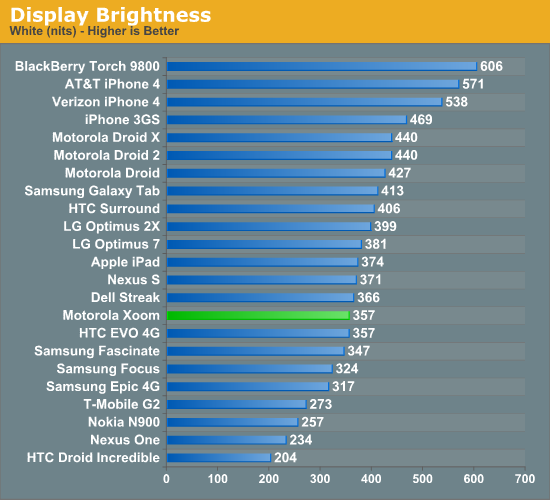

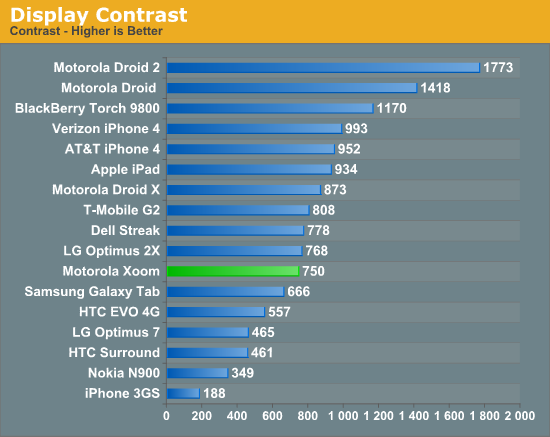
The bad news is the screen isn’t all that impressive. On my sample I measured a peak brightness of 356 nits and a black level of ~0.48 nits, resulting in a 750:1 contrast ratio. This puts the Xoom near the iPad in terms of brightness and lower contrast. In practice the lower contrast ratio is noticeable:

Motorola Xoom (left) vs. Apple iPad (right)

Motorola Xoom (left) vs. Apple iPad (right)
In practice the lower contrast ratio makes the Xoom almost completely unusable in daylight. If you can shadow the screen with your head it’s less of a problem but it’s still a pain to use outdoors in the daylight particularly if you’re staring at a dark colored background. Web pages and the email apps are easier thanks to their white background.

Motorola Xoom (front) vs. Apple iPad (back)
The iPad in particular has better color reproduction at off-center viewing angles. Alone, the Xoom looks acceptable. Not great, but not horrible either.
Finger prints and glare are issues on the Xoom display just like they were on the iPad’s display. You’re going to want to carry around a microfiber cloth with you at all times.


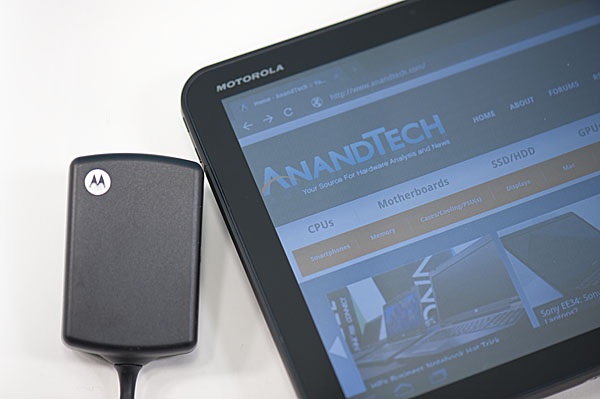
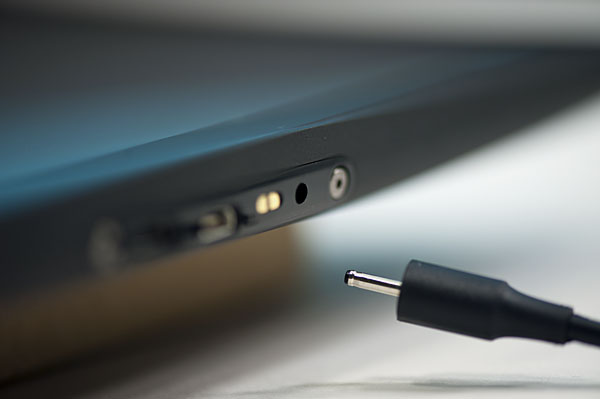
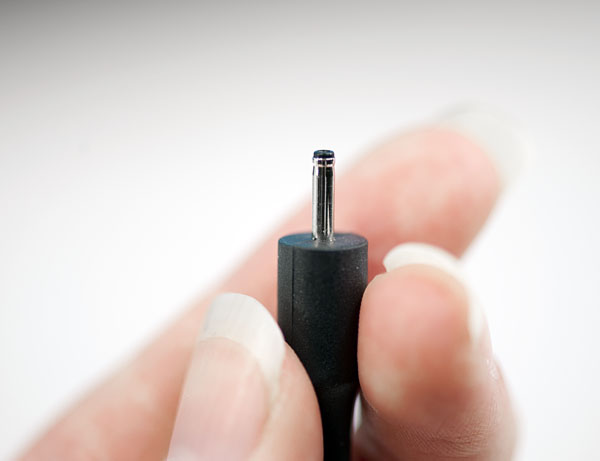
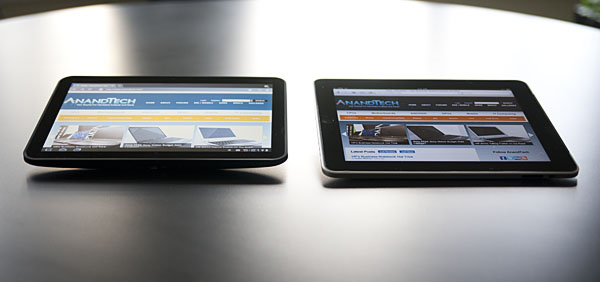








112 Comments
View All Comments
GotThumbs - Friday, March 18, 2011 - link
The platform is not that old. Apple just took their existing ois from the itouch and made it bigger. This is a whole new ballgame. Early adopters should understand their will be some hiccups...Glad to hear the WIFI only version is coming out March 27th for 599.00 This brings the competition directly to ipad and ipad2. My boss offered to buy me the ipad2 and I told him I only want an ADAM or a Xoom. An ipad would be a waste of money....I need a business tablet. Not one whose product is so proprietary...that you can't even load an app unless its through their store....how controlling is that?
Thermogenic - Thursday, February 24, 2011 - link
Samsung changed some of the basic internals of the system (I believe mainly to do with the filesystem and location of certain files). This makes it harder on them to release updates and also causes compatibility problems with certain applications.For me, I would only stick to the high end HTC and Motorola phones - they have the proven track record of updates. If you really want the latest and greatest for some reason, then you will want the Nexus line of phones.
ph00ny - Monday, March 7, 2011 - link
Not entirely true. Most custom froyo roms were based on galaxy s from overseas. Look at captivate, AT&T's froyo update just came out and the same phone offered through canadian carrier had froyo for quite some time nowchocks - Thursday, February 24, 2011 - link
"Android however did it the simplest way possible: tap home and run what you want to run next." Pre-Honeycomb Android has press-and-hold on the Home button which brings up a list of recently-used apps and can be used to switch between running tasks. Has had this since the first release I think.Anand Lal Shimpi - Thursday, February 24, 2011 - link
Woops, you're right :) That's very much a precursor to what Google did in Honeycomb, and tap-and-hold home is now out.Updated!
Take care,
Anand
Thermogenic - Thursday, February 24, 2011 - link
It's not a true tablet, but the NOOKcolor is a nice device for the money. If you are willing to do a little dirty work (mainly writing to a microsd card and booting it - very easy), you get a very basic tablet with a very nice screen for $250.I imagine for most users who use their tablet for web browsing, facebook, twitter, and youtube, that's plenty and a great bargain.
I guarantee there will be a usable version of Honeycomb running on it within six weeks. There is already a functional version, although with a decided lack of applications and very unoptimized.
wumpus - Monday, February 28, 2011 - link
I can't imagine anyone else competing with a wifi only tablet. My guess is that there are two reasons to avoid releasing such: First, you can overcharge and let the consumer pay the subsidy (and then some) back to the carrier. Second: nobody tries to compare it to the nook.Enormously Hatworthy - Thursday, February 24, 2011 - link
I read so many of those tech blogs that sometimes I forget what a real review looks like. Good work.Some of those benchmark results are pretty odd.
I wonder if the disparity between the Optimus 2X and the Xoom might in some way be related to the dual-core support in Honeycomb? The optimus is running on 2.2 which I understand has limited (if any) support for multiple cores.
Maybe the benchmark apps are showing some measure of incompatibility with the new code? Just a wild guess.
cj100570 - Thursday, February 24, 2011 - link
Just once I'd like to read a review of any piece of mobile tech where the reviewer stuck to reviewing the hardware in his/her hands instead of constantly comparing it to an Apple product. For Christs sake, enough is enough already! And don't give me that "Apple Set The Bar" BS. I'm not buying what you're selling! I've owned 3 generations of iPhones, an iMac, and 2 MacBooks so I'm very familiar with Apple products and I have great respect for them. But the simple fact of the matter is that not everyone wants to live the iOS/OS X lifestyle and when they read a review of non Apple products I'm quite sure they don't want to see Apple brought up every other sentence.Enormously Hatworthy - Thursday, February 24, 2011 - link
It is annoying but whether we like iOS/iPad or not (and I don't, to be honest) it is the market leader in tablets right now. It's the frame of reference for buyers.I think they'd be doing their readers a disservice if they didn't make the comparison.
Notice that in laptop/desktop reviews you'll see scarcely a mention of Apple products (unless they're talking about size and weight).